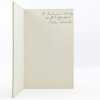1 books for « schneider isidor »Edit
Comrade Mister
New York Equinox Cooperative Press 1934 New York, Equinox Cooperative Press, 1934. [42] ff.. Reliure de l’éditeur, demi-toile rouge, plats biseautés. Petite tache sombre sur le plat supérieur. ÉDITION ORIGINALE de ce recueil de 41 poèmes parus pour la première fois dans les revues The New Masses, Dynamo, The American Caravan, The Nation, New York Herald Tribune Books, The New Republic et The Menorah Journal. L'ouvrage est illustré de deux dessins à l'encre de l'artiste hongroise Gyula Zilzer (1898-1969). Originaire de l'Empire Austro-Hongrois, Isidor Schneider emménagea aux États-Unis à l'âge de 6 ans. Il y contribua à de nombreux journaux libéraux, publiant d'abord des textes influencés par le mouvement Imagiste puis, dès les années 1920, des poèmes pro-communistes exhortant les travailleurs à l'action sociale. Ce recueil recoupe les deux époques de son oeuvre, avec 25 poèmes Imagistes et 16 poèmes pro-communistes séparés par l'essai "Toward Revolutionary Poetry", où l'auteur justifie la transformation de sa démarche : "Individualism had become more and more a malady. [...] As a consequence love poetry has fallen into morbid eroticism ; and the regard for nature into the contemplation of a wasteland. The world cries for a new social cohesion, and poets for a new theme." ENVOI DE L'AUTEUR À LA ROMANCIÈRE AMÉRICAINE SHIRLEY JACKSONet à son époux, le critique littéraire Stanley Edgar Hyman. "For Shirley and Stanley With affection Isidor Schneider" Célèbre auteur de romans d'épouvante fondés sur la désintégration psychique (The Haunting of Hill House, We have Always Lived in the Castle...), Shirley Jackson signa également la nouvelle "The Lottery" ("La loterie") qui fit scandale lors de sa publication dans le New Yorker.La couple, qui comptait parmi leurs amis de nombreux sympathisants communistes, fut fréquemment inquiété par le Maccarthysme. Quoi qu'ils n'aient jamais été ouvertement poursuivis, Shirley Jackson dénonça à plusieurs reprises cette "chasse aux sorcières" dans son ouvrage de vulgarisation à destination des enfants sur les procès de sorcellerie de Salem,The Witchcraft of Salem Village. FIRST EDITION of this collection of 41 poems which had previously been published in The New Masses, Dynamo, The American Caravan, The Nation, New York Herald Tribune Books, The New Republic andThe Menorah Journal.With 2 ink drawings by Hungarian artist Gyula Zilzer (1898-1969). Isidor Schneider moved from the Austro-Hungarian Empire to the US at the age of 6. There he contributed to many left-leaning journals and magazines. Though his first poems were strongly influenced by Imagism, with the turn of the 1920s, he began publishing pro-Communist poetry calling for the working class to demand social rights. This collection draws on both periods of his literary life, with 25 Imagist pieces and 16 Communist ones divided by the essay "Toward Revolutionary Poetry," in which the author justifies the shift in his work:"Individualism had become more and more a malady. [...] As a consequence love poetry has fallen into morbid eroticism ; and the regard for nature into the contemplation of a wasteland. The world cries for a new social cohesion, and poets for a new theme." INSCRIBED TO NOVELIST SHIRLEY JACKSON and her husband, literary critic Stanley Edger Hyman : "For Shirley and Stanley With affection Isidor Schneider" Most famous for her short story "The Lottery", which caused a scandal upon being published by the New Yorker, Shirley Jackson also authored severalhaunting novels of psychological disintegration(The Haunting of Hill House, We have Always Lived in the Castle...).Because their friend circles included Communist sympathizers, Jackson and her husband were, on more than one occasion, the subject of The House Committee on Un-American Activities' investigations. Though they were never arrested, Jackson denounced the Communist "witch hunt" in The Witchcraft of Salem Village, a children's book about the Salem witch trials. Publisher's binding, with red canvas spine and tan bevelled cardboard boards. Small dark stain on the upper board. Couverture rigide
 Write to the booksellers
Write to the booksellers



